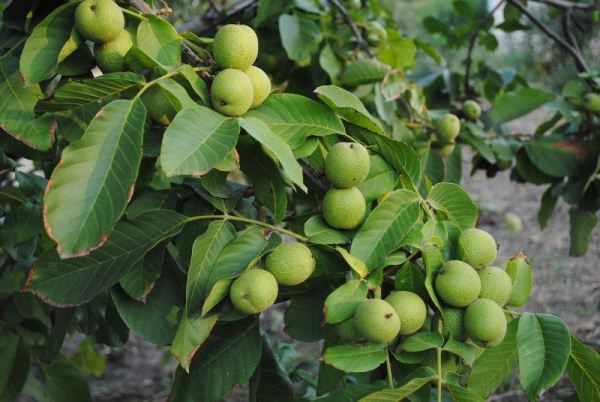Walnut - southern culture. This tall deciduous tree is very demanding of heat, moisture and light.. Traditionally, it grows and bears fruit in places where the average annual temperature does not fall below + 10ºС (Asia Minor, the Caucasus, the Balkan Peninsula). Therefore, the cultivation of walnut in most Russian regions is fraught with difficulties. Cultivation of specially bred varieties can be a way out. In the first place among them - walnut Ideal.
Table of contents
Description of walnut varieties Ideal
A rather serious problem for the cultivation of traditional walnut is its imminent entry into fruiting. Usually the seedling begins to produce only in the eighth, and sometimes in the fifteenth year of life.. Therefore, as early as the middle of the 20th century, breeders received the task: to produce a variety of fast-fruited walnut.
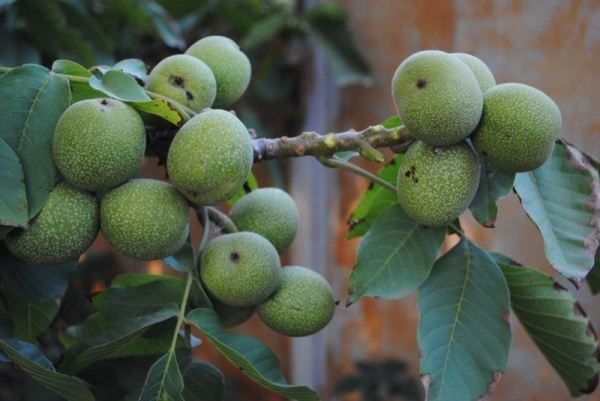
The problem was solved in 1947 by nut growers from Fergana (Uzbekistan). The honor of the opening of the variety Ideal belongs to the breeder S.S. Kalmykov.
Walnut Ideal is characterized by the following qualities:
| general description | The undersized variety does not grow above 4-5 m. The bark is gray, on 2-3-year-old shoots it is brown, on the annual ones it is blue-green, with a slight pubescence. Leaves are pinnate. On the vegetative shoots are arranged spirally, on the fruitful ones, they are underdeveloped in the lower part of the shoot, in the form of scales. |
|---|---|
| Skoroplodnost | The first fruits show already in the 2nd year of life. Good yields can be obtained from the 5th year. |
| Flowers | Small flowers of white color with a greenish tint, collected in a brush of 9-15 pieces. Wind pollinated, dioecious. |
| Fruit | Large (on average 10 g), oval, with a thin shell.The core is bright, easy to remove. Ripen from September to October. |
| Features of fruiting | Manages to generate 2 crops per year. |
| Yield | High, up to 120 kg from each tree. |
| Frost resistance | High, up to -35ºС. |
| Disease resistance | Resistant to chlorosis. |
| Soil requirements | Able to grow on acidic or saline soils. Does not tolerate close occurrence of groundwater. |
Thus, among the merits of the nut Ideal can be listed:
- precocity;
- yield;
- compactness of the tree;
- frost resistance;
- unpretentiousness;
- resistance to chlorosis;
- the ability to form two crops per season.
Unfortunately, the Ideal variety does not differ in durability compared to traditional forms. If ordinary walnut can live more 100 years, then skoroplodny - only about 40-50.
Another drawback - the flowers, falling under the spring return frosts, often damaged. Fortunately, the ability to secondary flowering compensates for this minus.
Breeding features
Walnut Ideal propagated by seeds or grafts. The process of growing it from seeds is fascinating and has a curious feature.: nuts should be placed in the hole close to each other, 4 pieces each. Then the seedlings will grow together and form a powerful and sustainable plant.
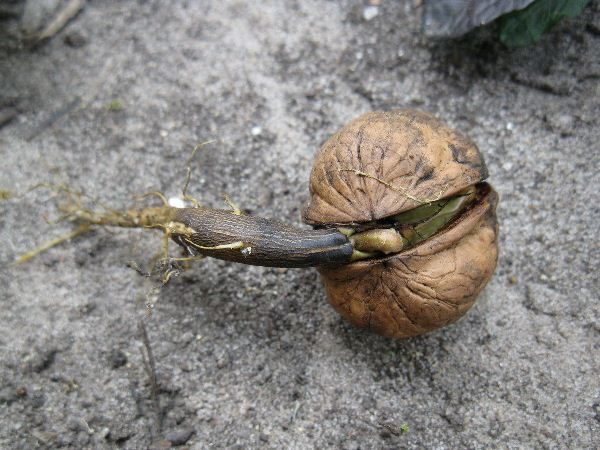
Walnut fruits are sown either before winter or in spring after the snow melted. In the second case, it is necessary to stratify the peanuts in wet sand during 1.5 months at a temperature + 7ºС and land already germinated material. Fruits are buried in wells 10 cm deep.
In the first year, the development of seedlings is rather slow. By the fall, they grow to only 15–20 cm. But next spring, the nut demonstrates a “growth spurt.” When the height of the seedling is over a meter, you can wait for the first flowers.
Graft walnuts best cuttings. The budding method is also used, but the vaccinated kidneys are likely to freeze out in winter. Walnut vaccinations are not always successful; therefore, you can find own-rooted seedlings for sale more often than on rootstocks.
Selection of seedlings
Nevertheless, choosing between the own-rooted and grafted walnut seedling, it is better to dwell on the latter.The fact is that in many seedlings obtained from seeds, the signs do not correspond to the parental forms. Walnut - cross-pollinated plant, and the seeds may not preserve the merits of the variety.
When buying a seedling you need to pay attention to its condition. Any damage to the bark, weak root system, rot on the roots should be alerted. Walnut is already poorly tolerated transplant, and additional “sore points” can make this procedure detrimental to the plant.
It is best to choose seedlings with a closed root system. Transplanting from a container together with an earthy ball will keep the growth and suction zones of the roots intact.
Walnut planting: step by step instructions
Land for planting seedlings should be well lit and covered from the cold northern winds. Walnut can not stand cramped, and his crown is rather sprawling,therefore, you need to retreat from other trees or buildings for at least 5 meters.
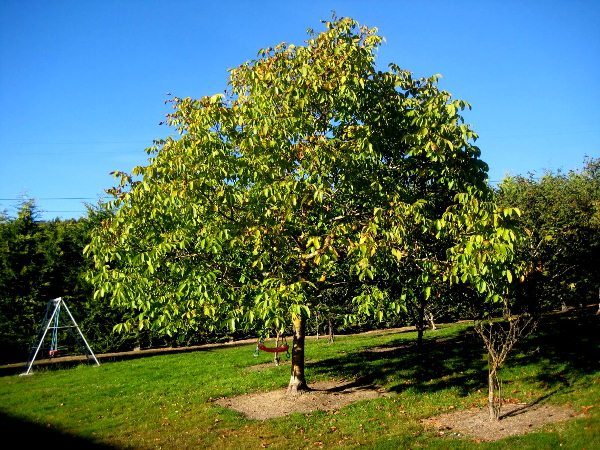
Despite the resistance of the Ideal variety to acidified soils, it will feel better on sod-calcareous loams. Swampy wet lowlands categorically do not fit him.
Planting a walnut seedling includes several operations and is carried out according to this scheme.:
- Soil preparation:
- On the day of planting, the planting pit is dug out. It is not necessary to prepare it in advance so that the soil does not dry out. Pit size - 60 * 60 cm. If the soil is infertile, the size increases to 100 * 100 cm.
- Fertile layer, removed by digging a hole, mixed with peat and mature compost in the ratio of 1: 1: 1.
- Soil mixture is enriched with fertilizers: dolomite flour - 500 g, superphosphate - 600 g
- Preparation of seedlings with an open root system:
- A clay mash is made: for 1 part of completely rotted manure, 3 parts of clay are taken, diluted with water to a creamy consistency and a root formation stimulator is added (“Hetero-Auxin” or “Kornevin”).
- The roots of the seedling are dipped in a small talker. and left for half an hour to dry.
- Planting seedlings:
- In the bottom of the pit mounted support. Soil mixture poured mound.
- The seedling is placed on the top of the planting hill.. Lower roots are distributed on the slopes and gently poured fertile soil. The upper ones are arranged horizontally, so that their depth is around 7-8 cm.
- The position of the root collar is checked. It should be 3-5 cm above the ground surface.
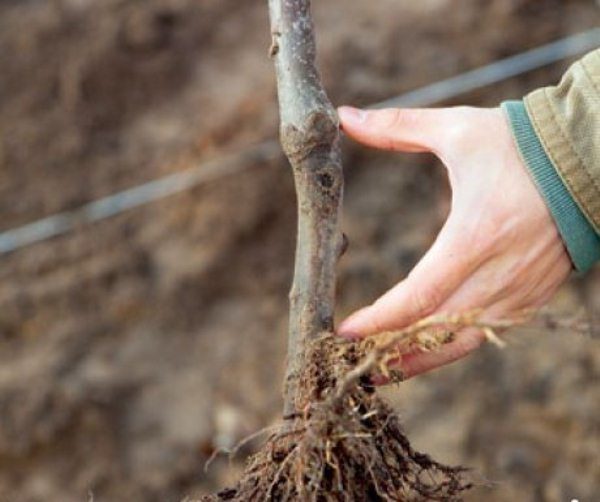
- Seedling is fixed to support.
- Pistol circle is watered and mulched.
If a container sapling was purchased, then it simply needs to be removed from the tank along with the soil clod and transferred into the landing pit. After that, pour the prepared soil mixture and pour.
Departure after landing
After 2 weeks after planting, the nut seedlings should be watered well. Water consumption rate - 15-20 liters. If the region does not belong to the zones of sufficient moisture, further careful monitoring of the state of the tree trunk will be required. Watering should be regular, but not excessive.
Ideal sapling nut needs to form a crown. If the landing was made in the spring, you can do the first pruning immediately. If the fall - you can postpone until spring. In an ordinary garden, a nut is formed into a “bowl.”. To do this, choose 3-4 good skeletal branches and cut off the center conductor above the top.

In the future, pruning will be required annually. The main principle is to provide maximum illumination of all parts of the crown. To do this, remove all the old and thickening branches. Walnut fruits on annual growths, and they need to give the most sun.
For normal winter preparations, the nut stops watering from mid-August. In late September, remove all the fruits and pruned the green tops of the shoots.. This procedure will force the plant to switch forces from growth processes to the aging of wood.
Reviews of amateur gardeners
In Primorsky Krai, the Ideal nut experienced winters with thirty degrees of frost and normally bore fruit every year. Collected from two trees on 4-5 buckets.I don’t know the age of the trees.
Excellent variety - carpal, skoroplodny. It is a pity, it is difficult to find it in a "pure" form. There are many hybrids based on Ideal. Also wrist, but nuts are not like that.
In February-March in the Moscow region was "burn" weather. The bark was heated to 15º during the day, clinging to frost at night. Walnut Ideal was sensitive, extinct above the level of snow cover. It is necessary to whiten high stambik.
Conclusion
Grow a walnut in the middle zone or other far from southern regions of Russia - the real challenge. Variety Ideal it successfully solves. Of course, as there are spots on the sun, and the Ideal can be found flaws. But many problems can be avoided by following the rules of agrotechnology of this wonderful culture.
